I’m featuring one of the most-asked questions by parents who are part of my infant and toddler classes.
Q: Hi teacher Tanya! I’m a first-time mom, still navigating myself through this new adventure of motherhood. Am I doing it right by letting my baby (three month old) just be? Will she be okay? I might be missing out important things she needs? I’ve read that I should make PLAY as part of her routine but I’m not that convinced why play is important for my baby. Please explain!
Mommy Ria
Dearest Mommy Ria,
Thank you for sending your question. Let me first define what “play is” so that we can understand it more in the context of raising babies.
Play can be defined as an activity that your baby loves doing. It is simple, spontaneous, flexible and led by the child (Centre of Excellence for Early Childhood Development, 2010, p.2).

My daughter Julia loved playing with her fingers when she was barely 3 months old.
Ruth Anne Hammond, in her book, Respecting Babies, explained that in the RIE® (Resources for Infant Educarers® ) approach, “play is what babies do when they are not involved in any caregiving activity (diapering, feeding, sleeping, etc). Simply put, this is what a baby does best and it comes naturally to him.
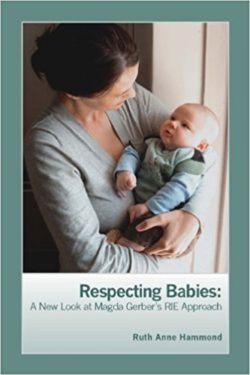
In my 13 years of working with children, I have not encountered a child who is not interested in playing (except when child is sick or going through a difficult time). I’ve always observed that when a child sees a toy, or a playground, his eyes seem to be drawn naturally towards it-whether he is alone or with others.
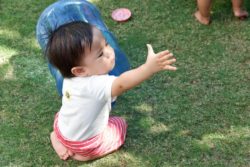
Jonah from our mobile infants class spent a long time exploring the grass.
A few questions that I want you to reflect on:
- Do you know that your baby can learn to play or explore on her own even from the beginning?
2. Do you know that infants are learning to learn?
3. Do you believe that an infant is capable of many self-initiated, self-motivated behaviours? And if an adult does not realize this, then it will be challenging for that adult to trust an infant to behave in such ways?
4. How does your baby look like when she is playing? Is she happy? excited? Focused?
5. What does your baby like to play with? A particular body part? Or does she like looking at the sun rays that stream through your window or does she enjoy staring at that little plant in your garden? Or simply the light up on your ceiling?
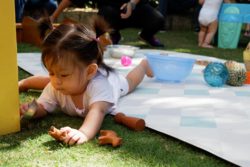
Stella spent a long time touching these play objects
Magda Gerber said in her book, “Your Self-Confident Baby”, a young baby has a particular unique agenda. That is to eat, sleep, explore her new world and be cared for. She explained that all the things happening around her- the light, the sounds, bodily sensations are all new for her. This is why their fast growing awareness and adaptation to the environment is all the stimulation that a newborn needs. When they get older, play objects or toys eventually become important.

Magda Gerber always pointed out that Infants need freedom in their play. She explained that value of self-initiated activity of children should start from the earliest age. This is done by giving your infant time for uninterrupted play, you build a habit that carries over as he grows up. It is actually making your life as a parent easier because you are helping your child become autonomous. his is why, play in whatever form, should be part of your baby’s day.
The RIE approach encourages us parents to trust in the child to be an initiator, explorer and self-learner. The beauty of the RIE approach is its balanced perspective on the value freedom of emotion and motion, as well.
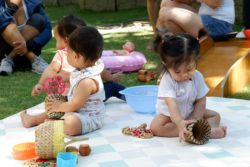
Our mobile babies engaged in various types of play.
Why do they need to PLAY? Here are 5 reasons why babies need PLAY in their routine, and more importantly, in their life! ( even when they get older)
Infants need freedom to explore and to freely choose activities that enhance their domains of development-physical, mental, emotional and social. When there is pleasure in the process of exploration and skill acquisition, Magda explains that it becomes self-reinforcing for the child. Your infant then becomes empowered, begins to feel capable of facing problems alone, rather than constantly expecting an adult to rescue him or do it for him.
1. Babies develop physically when they play.
Physically, an infant’s movements and play are often one and the same. Ruth Anne explains that babies need “a chance to recognise one’s own body parts, where adults offer the baby opportunity to find himself”. This means that until babies have really learned how to use their hands (this is what you call hand regard), then toys will not be of much use, at all. When babies discover their own hands, this becomes a signal for play and later on, hand-eye coordination. Touching, grasping, holding are also other forerunners of play.
It is best to provide opportunities for self-initiated movement by placing toys/objects within his reach. By doing this, you are respecting an infant’s readiness to play.
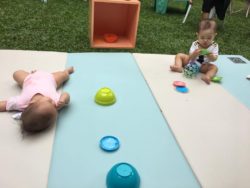
Our Saturday Infants Class.
In the book: Unfolding of Infants’ Natural Gross Motor Development, it was mentioned that the “unfolding of natural unassisted gross motor development” in infants is very important. This is because they move “naturally with better coordination, more body awareness, a natural sense of uprightness and more grace than when they are assisted by propping, being held upright or otherwise ‘helped’ to sit, stand, walk or climb.” (p.xi).
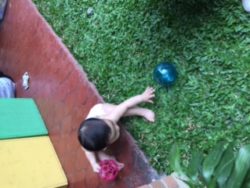
Zari is finding a position that will enable her to get the ball.
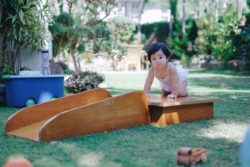
Milli taking it one step at a time to get up on the platform without help
Allowing the infant to move according to his pacing and freedom of movement enhances the quality of his movements. In return, the child learns to initiate on his own rather than depend on an equipment or an adult. More importantly, an infant’s independent, self-imitated motor activity develops other equally important skills: eye-hand coordination, eye-foot coordination, dexterity, bodily awareness, good poster, and judgment of how to move safely.
By allowing such freedom of movement within a secure and predictable relationship and environment, it enables the child to develop favourable emotional and intellectual abilities and coping skills that influence his personality development. This is why the RIE approach puts great value not just in MOTION but also in a child’s EMOTIONS.
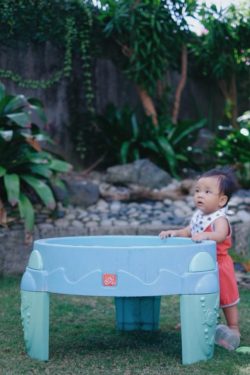
On their own, they can move physically without any assistance. Dutch showed us this principle.
2. Babies develop emotionally when they play.
Babies achieve their best emotional state when they are given uninterrupted time for play. Don’t we all want that for our baby?
This means that we don’t just interfere when they are playing with a toy, talking to himself, or even, when they are observing around them. Having an uninterrupted time for play enables them to express themselves-their curiosity, their need for social experiences. It simply accomplishes their need for an activity.
Play also allows the infant to develop that motivation to seek forms of stimulation that he can have control over. This means that we, as parents should not be worried that our babies will be bored if we don’t constantly move them, bounce them around or stimulate them all the time. This is because infants need to be able to learn how to self-soothe himself, how to initiate his own movement, how to regulate himself. And playing actually helps him to achieve this.

The Look of JOY in Ping’s face
Play is an opportunity to help strengthen your child’s self-respect and her sense of self-reliance. According to Magda, the goal is for your child to be the initiator of the play and for it to her her experience. She points out that we should not rob a child of the satisfaction of discovering the solution to a particular problem, we should enable them to go through the process of doing it herself- this is the crucial, competence and confidence-building factor. Our children are very good problem solvers if given the opportunity. Don’t we want our infant to trust in her ability to solve her own problems?
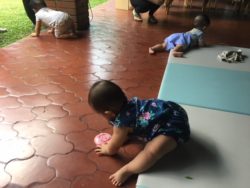
Look at Mica’s focus and motivation to get hold of this play object
Ginsburg (2007) stressed that “undirected play allows children to learn how to work in groups, to share, to negotiate, to resolve conflicts, and to learn self-advocacy skills” (p.183).
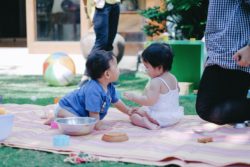
Ethan and Milli negotiating on a particular toy

In our program, we learn social skills by being with each other, playing beside them.
It is a misconception that babies have short attention span. They can become involved and play with a particular toy for a long period of time. They become involved in what interests them. As a mom, I always see this as my 2 daughters were growing up (transitioning from being an infant to toddler years), no amount of distraction or interruption can take their attention away from what they are most interested in. Whether it is figuring out how to get inside the box, or building blocks. It is that focus and attention that keep me them playing for hours.
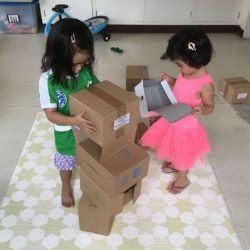
My daughters and their love for boxes.
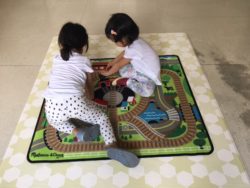
Pretend Play using various props and a play mat
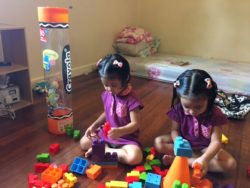
Building blocks can take hours
3. It is good for their brain development.
I love this saying from Diane Ackerman, “Play is our brain’s favourite way of learning”. Studies show the positive effects that play has on your infant’s development.
Babies thrive on both exploration and interaction. Their ability to move about, to touch things around them, to babble/coo at a familiar person, opens up a new world for them. When they explore, they truly become absorbed as they play.
According to Sutton-Smith (1997), an infant’s early experiences are important in the development of neural pathways/connections for the brain development. Play functions as a way to help reach the brain’s potential, otherwise, lack of any stimulus will lead to some loss of these essential neural connections.
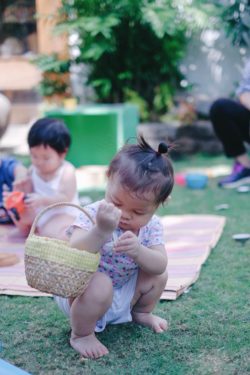
You might wonder what your child is learning when he keeps on touching a ball, and then later, throws it, and then touches it again. It looks purposeless, but something great is happening here. Through practice and repetition, it paves the way in building your child’s brain and promotes fast responses in his central nervous system.

Magda Gerber pointed out that “children are very good problem solvers if given the opportunity”. Another study done by David Caruso as written in Young Children (September 1988), that findings from follow-up studies confirmed the importance of infants’ spontaneous play in relation to cognitive growth as measured by later IQ tests. When the babies were tested, the babies allowed to play freely had higher IQ scores.
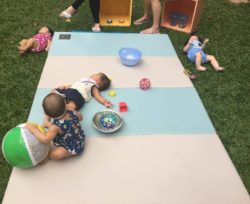
According to the book: Authentic Relationships in Group Care by RIE, more dexterous and complex play results when infants solve these spatial, non-verbal problems for themselves. They learn not only how to move, but also how to navigate across the room to reach their favorite object and how to use an object in a variety of ways. It is through these early coping skills that correlate with an attitude that is: optimistic, self-confident toward solving problems.
4. Babies develop their language skills when they play.
When babies babble, coo and make facial expressions back at you, this kind of playful interaction signals the start of their language development.
According to Gardner-Neblett & Gallagher (2013) in their article, More than Baby talk, explained that the way we communicate with our children and our interactions with them will greatly influence how they develop and learn. They stressed that based on studies done by Snow, CE et al (1994) and Walker, D, et.al (1994) children who develop strong language and communication skills are more likely to arrive at school ready to learn, and they are less likely to have reading difficulties and are more likely to have higher levels of achievement at school.
Research pointed by Ruth Money in her article: The RIE Early Years ‘Curriculum’, it has shown that infants have a built-in capacity to acquire language naturally, as self learners in an environment where language is spoken.
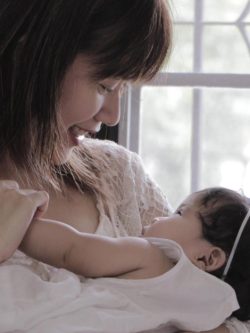
How do you communicate to your baby?
When we let our babies express themselves, this is enabling them to play with words. We encourage them further by responding to them and by giving our full attention during this interaction. We don’t simply talk at them, but we focus more on listening to them and being sensitive to the different cues that they are sending us.
Ruth Anne (2009) explains this as not talking at children but listening as much and not interrupting their concentration on a task just to teach them words. The RIE principle suggests applying this respectful communication during caregiving tasks; we communicate with the baby as we change their diaper, feed them, or bathe them.
5. It is an important foundation for formal education and life, later on.
Learning to play on her own is an aptitude that will serve your child well for life. This is because uninterrupted play promotes a longer attention span, which our children need when they get to the big school, and of course, when they eventually start working.
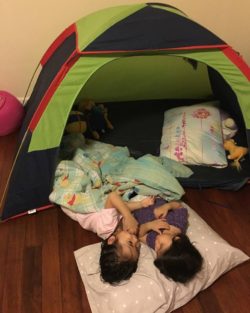
Research shows that there is a connection between play and the development of foundational skills such as in a child’s memory, self-regulation, oral language abilities, social skills and later success in school.
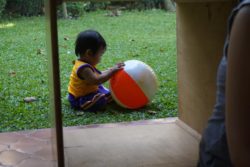
Play becomes the groundwork for the necessary skills that our child need when they enter school later on. As children play, they are involved with various experimentation that expose them to numerous concepts (science, math) and problem solving strategies which then “forms the basis for… higher-order thinking in all subjects” (Wyver & Spence, 1999, p.5). Because these are all learned through meaningful experiences, children are more likely to retain these information.
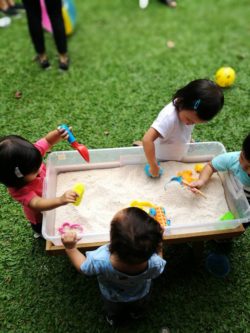
Magda Gerber always encouraged parents to understand that: A child should have a child’s life. Allowing your child a child’s life means letting her play peacefully at home, indoors or out, with her play interrupted only by daily caregiving necessities and occasional errands. One of my favorite child development professors and author, David Elkind, in his book: “The Hurried Child”, mentioned that all children need time to grow, to learn and to develop.
Mommy Ria, I really encourage that PLAY should not just be part of your baby’s routine but more importantly, it should be part of her LIFE (even until they grow old). It’s how they learn. It comes naturally for them.
I honestly believe that it takes so much effort to embrace this philosophy of play and to be able to give it to our children freely amidst the constant pressure to hurry up. I always always remind myself unto this day that I should go slowly with great patience and to celebrate the now because after all, they are children only once. I leave you with Magda’s encouragement to all parents: “Relax, and enjoy the wonders of infant development.”

References:
GARDNER-NEBLETT, N., & GALLAGHER, K.C. (2013). MORE THAN BABY TALK: 10 WAYS TO PROMOTE THE LANGUAGE AND COMMUNICATION SKILLS OF INFANTS AND TODDLERS. CHAPEL HILL: THE UNIVERSITY OF NORTH CAROLINA, FPG CHILD DEVELOPMENT INSTITUTE.
Ginsburg, K.R. (2007). THE IMPORTANCE OF PLAY IN PROMOTING HEALTHY CHILD DEVELOPMENT AND MAINTAING STRONG- PARENT CHILD BONDS. AMERICAN ACADEMY OF PEDIATRICS, 119, 182-191.
Hammond, R.A. (2009). RESPECTING BABIES: A NEW LOOK AT MAGDA GERBER’S RIE APPROACH. WASHINGTON, DC. ZERO TO THREE.
Petrie, S., & Owen, S. (2005 ) Authentic Relationships in Group Care for Infants and Toddlers-Resources for Infant Educarers (RIE). Principles into Practice. UK: Jessica Kingsley Publishers


Comments are closed here.